Lecture
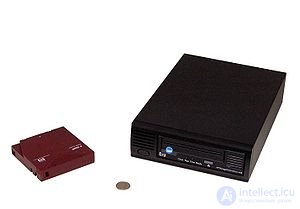
Streamer [1] (from the English streamer ), also a tape drive - a storage device based on the principle of magnetic tape recording, with sequential access to data, is similar in principle to a domestic tape recorder.
The main purpose: recording and playback of information, archiving and backing up data.
The technology of storing data on magnetic tape during the development of computing technology has undergone significant changes, and in different periods characterized by various consumer properties. The use of modern streamers has the following distinctive features.
Advantages:
Disadvantages:
There are two basic methods of recording information on a magnetic tape in tape drives:
When using this recording method, data is recorded on the tape in the form of several parallel tracks. The tape has the ability to move in both directions. The reading magnetic head is still at the time of reading, as well as the writing head during recording. Upon reaching the end of the tape, the read / write head moves to the next track, and the tape begins to move in the opposite direction. The technology is essentially the same as a domestic audio recorder. It is possible to use several heads that work with several tracks simultaneously ( multi-track streamer ). In modern devices, this method dominates.
If this method is used, the block of recording-reproduction heads (BGSV) is placed on a rotating drum, past which the mechanism pulls the tape, while reading and writing. Record while being in the same direction. Depending on the recording format used, the tape passes around the HDR at a certain angle, with the axis of the BGSV cylinder itself also inclined at a slight angle to the tape. Tape when writing, reading moves in one direction. This recording method assumes the presence of inclined tracks on the surface of the tape. A similar technology is used in video recorders. The oblique-line method was invented to achieve a higher recording density than the linear method, without the need to reduce the gap in the heads and increase the speed of the tape (however, at present, these technical limitations are overcome in the linear method).
The magnetic tape was first used to record computer data in 1951 at Eckert-Mauchly Computer Corporation on an UNIVAC I computer. A thin strip of metal 12.65 mm wide consisting of nickel-plated bronze (called Vicalloy) was used as a carrier. The recording density was 128 characters per inch (198 micrometers / character) on eight tracks.
In computers manufactured before the appearance and wide distribution of hard disks, magnetic tape drives (NML), similar to tape drives, were used as the main long-term storage medium. Later, in NML mainframes, they were used in hierarchical media management systems for storing rarely used data. For some time they were widely used as a removable storage device when transferring a large amount of information.
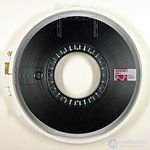
The widespread use of tape drives was associated with large computers and, in particular, IBM mainframes. Beginning with the IBM System / 360 family introduced in 1964, IBM adopted the standard 9-track linear recording tape, which later also spread to systems from other manufacturers and was widely used until the 1980s. In the USSR, this standard of magnetic tapes absolutely dominated, thanks to the use of tape drives of the family of EU computers, including as part of computers of other architectures.
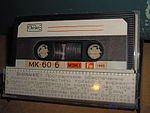
In the home personal computers of the 1970s and the early 1980s (up to the mid-1990s), in many cases, a common household tape recorder or, occasionally, special devices based on it with automatic control were used as the main external storage device. This technology was not sufficiently adapted for computer needs, but it was very cheap and accessible to a home user (since many of them already had an audio tape recorder). For industrial PCs, streamers such as TEAC MT-2ST with CT-500H, CT-600H 50 and 60 MB cassettes were used, respectively.
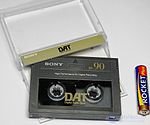
The DDS ( Digital Data Storage ) data storage format was developed in 1989 by Hewlett-Packard and Sony based on the Digital Audio Tape (DAT) format developed by Sony and Philips in the mid-1980s. In appearance, it resembles a twice reduced audio cassette, since it is a four-millimeter magnetic tape enclosed in a protective plastic case of size 73 mm × 54 mm × 10.5 mm. As the name suggests, tape recording is digital, not analog, using 16-bit pulse-code modulation (PCM) without compression, like a CD, and the sampling rate can be as much as CD (44 , 1 kHz), and less, namely: 48, 44.1 or 32 kHz. This means that the recording is done without losing the quality of the original signal, in contrast to the later formats DCC (English Digital Compact Cassette ) and MD (English MiniDisc ). DDS drives use a recording technique similar to that used in DAT audio tape recorders and based on both moving the media in the horizontal direction and reading-writing heads in the vertical direction.
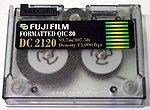
In the 1990s, the QIC-40 and QIC-80 standards, which used small tapes with a physical capacity of 40 and 80 MB, respectively, were popular for personal computer backup systems. Supported hardware data compression. The drives of these standards were installed in a standard 5-inch bay and connected to the interface of a floppy disk controller. In the future, a large number of similar standards under the trademarks QIC and Travan, defining media with a capacity of up to 10 GB, appeared.
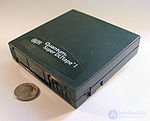
DLT technology was introduced by Quantum in the early 1990s based on the earlier CompacTape technology for VAX computers from Digital Equipment Corporation, the tape division of which acquired Quantum. A further development of DLT was the Super DLT (SDLT) technology.
The range of standards CompacTape / DLT / SDLT defines media physical capacity from 100 MB to 800 GB.
Since 2007, the development of the SDLT standard by Quantum has ceased in favor of LTO, but equipment and recording media are still being produced.
Modern tape drives are usually connected via a high-performance SAS interface, which provides data transmission at 3 or 6 Gbps. Older IBM models have the ability to connect through the FICON interface.
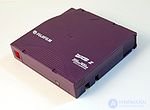
Currently, the market is dominated by streamers corresponding to the line of standards LTO (Linear Tape-Open).
The LT235 TS2350 streamer introduced by IBM is equipped, in addition to two SAS interfaces, also an Ethernet interface. However, at present (June 2010) this interface cannot be used, it is declared reserved for future firmware versions [2] .
IBM currently supplies, in addition to LTO equipment, streamers of its own proprietary standard IBM 3592 (Jaguar), presented by the modern model IBM TS1140 [3] , as well as compatible tape libraries. This equipment is used in servers and mainframes. The IBM 3592 line includes the streamer models of the actual 3592 (1st generation), TS1120 (2nd generation), TS1130 (3rd generation) and TS1140, as well as tape libraries based on them. Cartridges have a physical capacity of up to 4 TB.
Being, in contrast to the LTO standard, is focused not only on archiving and backup, but also on random access to data, the IBM 3592 standard ensures that the more stringent requirements for the number of media rewrites are met. IBM 3592 also used a number of solutions to optimize performance in start-stop recording mode, such as deep data caching and multi-speed tape movement (6 or 7 speeds, depending on the tape drive model).
The IBM 3592 uses the linear write method.
A distinctive feature of the IBM 3592 standard is the possibility of reformatting the old generation of magnetic media into the format of newer devices with a corresponding increase in information capacity (unlike other modern standards that ensure compatibility of old devices with old media only in the old format). In the general case, compatibility is provided for 2 generations forward, the specific allowable modes of use of a particular carrier in a particular device are determined by the table:
| Belt length (m) | Streamer 3592 J1A | Streamer TS1120 | Streamer TS1130 | Streamer TS1140 | |
|---|---|---|---|---|---|
| 3592 JJ / JR Cartridge | 610 m | 60 GB | 100 GB | 128 GB | |
| 3592 JA / JW cartridge | 610 m | 300 GB | 500 GB | 640 GB | |
| 3592 JB / JX cartridge | 825 m | 700 GB | 1 TB | 1.6 TB | |
| 3592 JC / JY cartridge | 4 TB | ||||
| 3592 JK cartridge (short JC) | 500 GB |
Currently, IBM Research and FujiFilm offer a technology that allows recording up to 35 terabytes of data on a tape cartridge comparable in size to LTO. However, the question of ensuring sufficient bandwidth of the device connection interface and the device blocks itself remains open: modern LTO-5 devices oriented to a 6 Gb / s SAS interface connection with an actual bandwidth of 140 MB / s would take about 3 days for recording 35 terabytes of data [4] .
In Unix-like operating systems, the simplest, but in many cases sufficient, work with the tape drive is supported from the command line using the tar and mt commands (the exception is Mac OS X, in which mt is absent, and tar does not support streamers). More advanced backup tools are provided with special programs available for all common operating systems.
In 2010, IBM introduced the free file system LTFS ( English ) for tape drives that support partitioning, which include LTO-5 tape drives and IBM 3592 / TS1120 / TS1130 [5] . This file system allows you to access the contents of the tape, as a normal directory tree with files. Currently, LTFS is implemented by IBM for Linux and Mac OS X platforms, work is underway on an implementation for Windows.
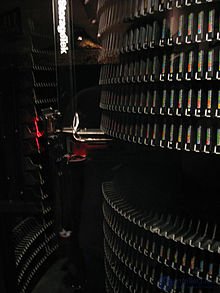
A tape drive that supports simultaneous operation with multiple tapes is called a tape library. Robotic tape libraries can contain storages with thousands of magnetic tapes, of which the robot automatically takes the required tapes and installs into one or more read / write devices. From a programmatic point of view, such a library looks like one drive with a huge capacity and significant random access time. Cassettes in the tape library are identified by special barcode labels that the robot reads. Currently (2010), tape library libraries with a capacity of up to 70 petabytes are commercially available with 70,000 cassettes [6] .
A tape library has significant advantages over a disk array in terms of cost and power consumption for large amounts of stored data. For example, according to the calculations of the 2008 edition of Clipper Notes [7] , in order to maintain an archive of 6.6 petabytes for 5 years, the cost of a disk system (RAID arrays, controllers, splitters, drives, power, cooling, etc.) will amount to 14.7 million dollars (including the cost of electricity - 550 thousand dollars), while the cost of the tape library is less than 700 thousand dollars (including the cost of electricity - 304 dollars). The disadvantage of a tape library is random data access time, which in normal operation can reach several minutes, as well as a drop in performance by orders of magnitude with an increase in the number of different simultaneous requests more than the number of read-write devices (when the tapes turn out to be queued to the device).
Comments
To leave a comment
Electromechanical devices of electronic devices
Terms: Electromechanical devices of electronic devices